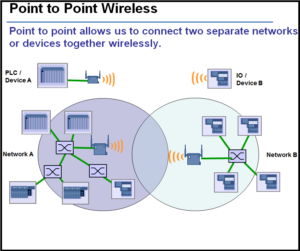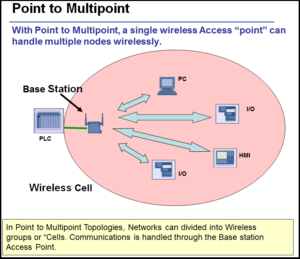Wireless Architectures
When speaking about wireless PROFINET communications for industrial automation, there are a variety of architectures available depending on the application. Overall, there are four main possible architectures:
- Point to Point
- Point to multipoint (Infrastructure)
- Wireless distributed system
- Mesh
Also, there is an option between Wifi or Bluetooth. PROFINET devices with Wifi/Bluetooth capabilities are readily available by a variety of vendors. Check the PI Product finder to find existing products (hint: select PROFINET and the wireless filter to display only those products).
Point to Point (P2P) or Ad-Hoc
P2P connections can be accomplished with Bluetooth or WiFi. Typically, P2P architectures have a dedicated wireless connection between two devices, between two APs (Access Point), or between a device and an AP. These devices could be for example a PROFINET controller and IO device. Sometimes devices have wireless capabilities builtin, making a separate APs unnecessary. The main advantage of P2P is the dedicated channel for communications. The channel is not shared, therefore more bandwidth is available on the wireless link. It should be noted that most Bluetooth applications use P2P connections as their primary method of communications.
Point to Multipoint (P2M / Infrastructure)
P2M architectures are mostly done via WiFi, but Bluetooth is also an option. With P2M, users can tie multiple wireless stations (clients) to a controller or other devices (PC / Scada) through a single AP. Most wireless networks use a wireless infrastructure (P2M) as the main wireless mode. For example, you could have a laptop, an HMI, and a PROFINET network consisting of multiple devices all accessible via wireless.
Wireless Distributed System (WDS)
A WDS allows the use of a wireless backbone between multiple APs. In this case, a client could ‘roam’ between the cells allowing communication to be handled seamlessly. This would work well for automated guided vehicles or other moving wireless components.
Mesh
Mesh wireless networks are fairly new to the industry, but they are important for low power devices in process and sensor networks. For these applications, sending data at a slower rate (in seconds) is the norm, devices enter a ‘sleep’ state until awakened by a change in the process.
This article originally appeared as a lesson at PROFINET University



